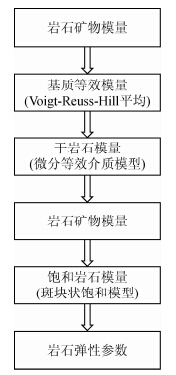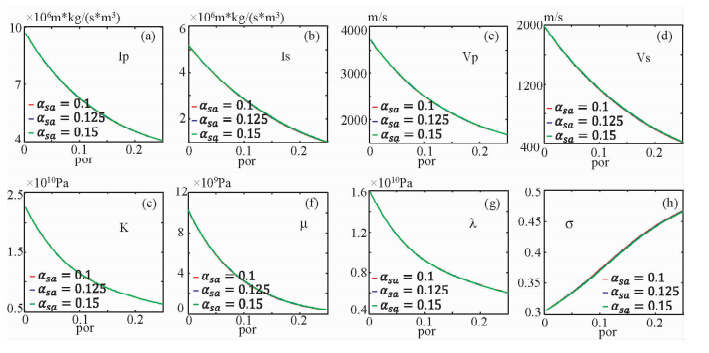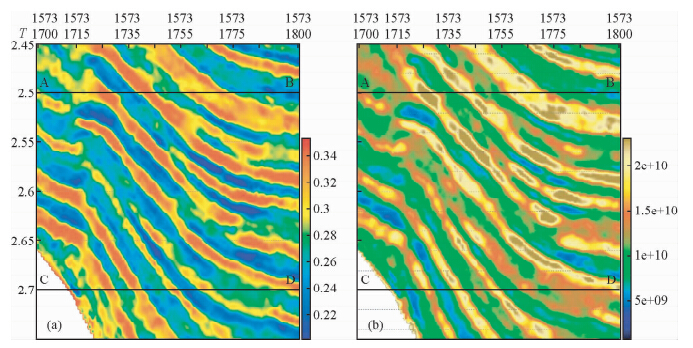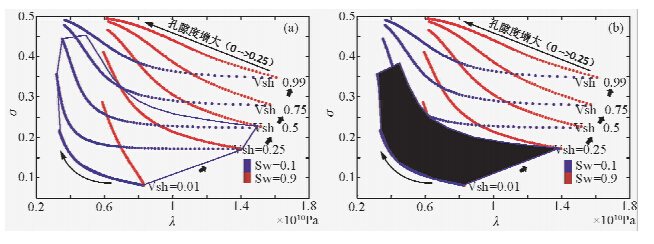岩石物理学搭建了储层参数和岩石弹性参数之间的桥梁(Wang,2001;Mavko et al., 2009),是地震储层研究、岩性识别和油气检测的理论基础,通过岩石物理建模,可以建立孔隙度,含水饱和度和孔隙纵横比等储层参数与岩石弹性参数等之间的岩石物理关系,便于更加合理的分析和研究储层特征,减少勘探开发风险.
为了寻找储层物性与地震属性之间岩石物理关系,很多学者做了大量研究.Xu和White(1995)考虑了砂岩孔隙和泥岩孔隙的几何形态,给出了适用于常规砂泥岩储层的Xu-White模型;Keys和Xu(2002)引入干岩石近似对Xu-White模型中干岩石模量求取方法进行了改进;Lee(2006)将孔隙形状的影响归因于压实效应,通过改进Pride等(2004)提出的计算压实砂岩干岩石模量的公式,给出了基于固结系数的岩石物理模型;Smith等(2009)分析了低孔低渗砂岩储层特征,将KT模型(Kuster and Toksz.,1974;Berryman,1980)应用于低孔低渗储层;聂建新等(2010)给出了一个描述含泥质低孔渗孔隙各向异性介质中波传播规律的黏弹性Biot/squirt(BISQ)模型;Ruiz和Cheng(2010)、 Ruiz和Azizov(2011)基于自相容近似模型,给出了适用于致密砂岩气储层的SPM模型和SAR模型;白俊雨等(2012)基于Xu-White模型进行了横波速度预测误差的分析,综合分析了模型中砂、泥岩和孔隙流体弹性参数以及孔隙纵横比等输入参数的误差对预测横波速度精度的影响;张广智等(2012)在Xu-White模型的基础上给出了基于修正Xu-White模型的碳酸盐岩横波速度估算方法;张佳佳等(2012)通过改进Nur(1992)提出的临界孔隙度和岩石骨架弹性模量之间的关系式,给出了预测横波速度的可变临界孔隙度模型等;郭继亮等(2012)基于岩石物里学中临界孔隙度模型,建立一种简洁的均匀弹性流体饱和孔隙介质模型,并进行地震波传播研究;张广智等(2013)等,给出了基于碳酸盐岩裂缝岩石物理模型的横波速度和各向异性参数预测方法;巴晶等(2013)基于Biot-Rayleigh波动方程,实现了对非饱和岩石的多尺度理论建模,预测了不同尺度下波响应与岩性、流体间的定量联系;唐晓明等(2013)对孔隙、裂隙介质弹性波理论进行了实验研究,指出其能够很好地描述岩石在干燥和饱和状态下纵、横波速度随压力的变化;Avseth等(2014)通过对沉积岩石特征的研究给出了适用于中低孔隙的岩石物理模型,其中高孔隙采用CCT模型(Dvorkin and Nur, 1996),低孔隙为DEM模型(Berryman,1992),高低孔隙的过渡用HS上限(Hashin and Shtrikman, 1963);陈怀震等(2014)从各向异性岩石物理模型出发,引入可有效识别缝隙流体的指示因子,并研究缝隙充填流体类型、饱和度以及缝隙纵横比与流体因子的相互关系,进而分析不同流体充填时介质的地震响应特征,并基于AVAZ反演方法估测缝隙流体指示因子;董宁等(2014),在自洽模型和微分等效介质模型的基础上,引入Berryman三维孔隙形态及Brown-Korringa固体替代技术,建立适用于富有机质泥页岩的新型岩石物理模型等等.
岩石物理模型作为求取岩石弹性参数的主要途径,其准确性与适用性制约了其实际应用的范围,不同岩性储层需要建立不同的岩石物理模型.基于确定的岩石物理模型,可以合理有效地进行岩性识别和流体检测等.本文基于微分等效介质模型构建适用于砂泥岩的岩石物理模型,分析了砂泥岩弹性参数与储层物性之间的关系,并绘制了砂泥岩储层岩石物理交会模板,不同于常规交会分析,该弹性参数交会模板综合考虑了孔隙度、含水饱和度、泥质含量和孔隙纵横比等储层弹性参数的影响,可以更加合理的界定出储层的砂、泥 岩范围,而且根据泥质含量等参数的不同,可以进一步做到储层岩性的精细识别,体现了该模板的优势,方便寻找储 层.
1 岩石物理模型
砂泥岩储层岩石物理建模中,经常用到微分等效介质模型(Xu and White, 1995,1996;Keys and Xu, 2002;Avseth et al., 2014),本文亦是基于微分等效介质理论建立了砂泥岩模型.模型的建立遵循由基质到干岩石骨架再到流体饱和岩石的步骤,如图 1流程.使用VRH平均公式(Hill,1952)由岩石矿物模量得到等效岩石基质模量.干岩石模量的求取需要已知岩石孔隙度和孔隙几何形状,砂泥岩储层中,孔隙分为砂岩孔隙和泥岩孔隙,砂岩孔隙的孔隙纵横比大都在0.1~0.15,泥岩孔隙的孔隙纵横比多在0.02~0.05(Xu and White, 1995,1996).使用微分等效介质理论计算干岩石的弹性模量时,假设孔隙流体的弹性模量为零.Berryman(1992)给出了等效体积和剪切模量耦合的微分方程组.为了便于计算这里给出其差分形式为

 | 图 1 岩石物理模型流程Fig. 1 The flowchart of the rock physical model |
为了考虑砂泥岩储层流体分布的非均匀性,采用斑块状饱和模型(Hill,1963)求取饱和岩石的体积模量 Ksat和剪切模量μsat:

其中Kdry和μdry分别为DEM模型得到的干岩石体积模量和剪切模量;Kma和Kfl分别为基质体积模量和流体体积模量;Sw、Sg和So分别为含水饱和度、含气饱和度和含油饱和度;Ksat,water、Ksat,gas和Ksat,oil分别为Gassmann公式(Gassmann,1951)求取的孔隙中分别饱含水、气和油的体积模量.
上述岩石物理模型充分考虑了孔隙度、含水饱和度、泥质含量和孔隙纵横比等储层特征,利用该砂泥岩模型可以较好的分析储层物性与岩石弹性参数等之间的关系,有利于进行储层岩性识别和流体检测.
2 弹性参数影响因素分析
弹性参数变化规律是岩石物理研究的主要内容之一(李维新等,2007).砂泥岩储层的弹性参数会因为储层孔隙度、泥质含量、含水饱和度和孔隙纵横比等因素的不同发生变化.深入了解岩石弹性参数与储层物性的关系,有利于寻找储层岩性识别和流体检测方法,为岩石物理交会模板(本文即弹性参数交会模板)的建立提供理论基础.
利用表 1数据和所建立的岩石物理模型,对砂泥岩储层的弹性参数,如纵横波阻抗、纵横波速度、体积模量、剪切模量、拉梅参数和泊松比等进行理论分析.
| | 表 1 输入数据 Table 1 Input data |
岩石是由岩石骨架和孔隙流体组成的二相体,岩石的弹性参数则表现为这样的二相体的等效弹性参数.因此岩石的弹性不仅决定于固体骨架(矿物)的弹性性质,岩石中孔隙的大小、孔隙的几何形状以及孔隙中流体的性质等都将对这种二相体的弹性性质产生巨大的影响(陈颙等,2009).砂泥岩储层固体基质主要为砂岩和泥岩,分析基质对岩石弹性参数的影响,需要考虑各组分的贡献,可以通过泥质含量的变化来研究.孔隙对岩石弹性参数的影响表现在两个方面:孔隙含量和孔隙形状.孔隙含量,即孔隙度的大小,决定着孔隙流体对岩石弹性参数的影响.孔隙形状多用孔隙纵横比描述,按照孔隙纵横比的大小,可将储集空间分为裂缝,粒间孔隙和溶洞等.砂泥岩储层存在两种孔隙:砂岩孔隙和泥岩孔隙,砂岩孔隙纵横比多集中0.1~0.15,泥岩孔隙纵横比多集中0.02~0.05.
图 2和图 3为不同泥质含量时,弹性参数随孔隙度和砂岩孔隙纵横比的变化图,孔隙度的变化范围是0~0.25.泥质含量低时,如图 2,随着孔隙度的增加,除泊松比外,其它弹性参数均呈现减小的趋势,改变砂岩孔隙纵横比,各弹性参数有变化但不明显,其中砂岩孔隙纵横αsa=0.1时各弹性参数的变化略大.泥质含量高时,如图 3,孔隙度的影响明显,但变化砂岩孔隙纵横比,各弹性参数几乎不发生变化.可以得到,砂岩孔隙纵横比(变化范围0.1~0.15)对岩石弹性参数的影响较小,泥质含量增加会削弱该因素影响.
 | 图 2 泥质含量Vsh为0.15时,弹性参数随孔隙度por和砂岩孔隙纵横比αsa变化图 泥岩孔隙纵横比0.03,含水饱和度0.9,(a)为纵波阻抗,(b)为横波阻抗,(c)为纵波速度,(d)为横波速度,(e)为体积模量,(f)为剪切模量,(g)为拉梅参数,(h)为泊松比.Fig. 2 The change of elastic parameters with the porosity and the aspect ratio of s and pore αsa,with the shale content Vsh 0.15 the aspect ratio of shale 0.03,the water saturation 0.9,(a)impedance of the P-wave velocity,(b)impedance of the S-wave velocity,(c)P-wave velocity,(d)S-wave velocity,(e)bulk modulus,(f)shear modulus,(g)Lame constant,(h)Poisson’s ratio. |
 | 图 3 泥质含量Vsh为0.85时,弹性参数随孔隙度por和砂岩孔隙纵横比αsa变化图 泥岩孔隙纵横比0.03,含水饱和度 0.9,(a)为纵波阻抗,(b)为横波阻抗,(c)为纵波速度,(d)为横波速度,(e)为体积模量,(f)为剪切模量,(g)为拉梅参数,(h)为泊松比.Fig. 3 The change of elastic parameters with the porosity and the aspect ratio of s and pore αsa,with the shale content Vsh 0.85 The aspect ratio of shale 0.03,the water saturation 0.9,(a)impedance of the P-wave velocity,(b)impedance of the S-wave velocity,(c)P-wave velocity,(d)S-wave velocity,(e)bulk modulus,(f)shear modulus,(g)Lame constant,(h)Poisson’s ratio. |
图 4和图 5为不同泥质含量时,弹性参数随孔隙度和泥岩孔隙纵横比的变化图,孔隙度的变化范围是0~0.25.随孔隙度的增加,除泊松比外,各弹性参数呈现减少趋势,其具体变化情况会因泥质含量的变化有所不同.不同于图 2和图 3,变化泥岩孔隙纵横比,各岩石弹性参数均变化较为明显,其中泥岩孔隙纵横比αsh取较小值0.02时,各弹性参数变化最为明显,减小泥岩孔隙纵横比,除拉梅参数和泊松比外其它弹性参数,均呈现减小趋势.分析可知,孔隙纵横比非常小的泥岩孔隙对岩石弹性参数的影响较为明显.
 | 图 4 泥质含量Vsh为0.15时,弹性参数随孔隙度por和泥岩孔隙纵横比αsh变化图 砂岩孔隙纵横比0.12,含水饱和度 0.9,(a)为纵波阻抗,(b)为横波阻抗,(c)为纵波速度,(d)为横波速度,(e)为体积模量,(f)为剪切模量,(g)为拉梅参数,(h)为泊松比.Fig. 4 The change of elastic parameters with the porosity and the aspect ratio of shale pore αsh,with the shale content Vsh 0.15 The aspect ratio of shale 0.03,the water saturation 0.9,(a)impedance of the P-wave velocity,(b)impedance of the S-wave velocity,(c)P-wave velocity,(d)S-wave velocity,(e)bulk modulus,(f)shear modulus,(g)Lame constant,(h)Poisson’s ratio. |
 | 图 5 泥质含量Vsh为0.85时,弹性参数随孔隙度por和泥岩孔隙纵横比αsh变化图 砂岩孔隙纵横比0.12,含水饱和度 0.9,(a)为纵波阻抗,(b)为横波阻抗,(c)为纵波速度,(d)为横波速度,(e)为体积模量,(f)为剪切模量,(g)为拉梅参数,(h)为泊松比.Fig. 5 The change of elastic parameters with the porosity and the aspect ratio of shale pore αsh,with the shale content Vsh 0.85 The aspect ratio of shale 0.03,the water saturation 0.9,(a)impedance of the P-wave velocity,(b)impedance of the S-wave velocity,(c)P-wave velocity,(d)S-wave velocity,(e)bulk modulus,(f)shear modulus,(g)Lame constant,(h)Poisson’s ratio. |
孔隙流体是影响岩石弹性参数的一个重要因素.对于砂泥岩储层油水充填的情况,随着含水饱和度的变化,岩石各弹性参数的变化各异.
图 6给出弹性参数随含水饱和度和泥质含量的变化图,孔隙度为0.2.随含水饱和度的增加,剪切模量保持不变,由于岩石密度随含水饱和度的增加略有增大,因此横波速度略有减小,横波阻抗会略有增加,其他弹性参数均呈现增加趋势.泥质含量的变化不会改变弹性参数随含水饱和度的变化趋势.
基于构建的砂泥岩模型,分析了岩石各弹性参数随不同储层物性参数的变化情况,相比,砂岩孔隙纵横比的影响较小,其他储层物性的影响均显著.要较好地识别砂泥岩,寻找储层和进行流体检测,需要全面分析各储层参数的影响.
 | 图 6 弹性参数随含水饱Sw和度和泥质含量Vsh变化图 泥岩孔隙纵横比为0.03,砂岩孔隙纵横比0.12,(a)为纵波阻抗,(b)为横波阻抗,(c)为纵波速度,(d)为横波速度,(e)为体积模量,(f)为剪切模量,(g)为拉梅参数,(h)为泊松比. Fig. 6 The change of elastic parameters with the water saturation Sw and the shale content Vsh The aspect ratio of shale 0.03,the aspect ratio of s and 0.12,(a)impedance of the P-wave velocity,(b)impedance of the S-wave velocity,(c)P-wave velocity,(d)S-wave velocity,(e)bulk modulus,(f)shear modulus,(g)Lame constant,(h)Poisson’s ratio. |
岩石弹性参数受到储层各类物性参数的综合影响,仅从单一储层参数很难合理有效地进行描述.储层地球物理研究中往往需要对储层不同的弹性参数进行交会,以找出可以识别岩性和流体的敏感参数.建立的岩石物理交会模板将储层物性参数反应在岩石弹性参数的交会中,将实际储层资料得到的弹性参数进行交会,投影到岩石物理交会模板上,可以直接从模板界定的岩性区域识别出储层岩性,如果储层矿物成分和含量确定,该模板可以从含水饱和度的不同进行一定的流体识别.
为了能够直观的反应砂泥岩各弹性参数随储层物性的变化情况,利用表 1参数和上述模型,构建图 7岩石物理交会模版.它充分考虑了不同孔隙度,不同泥质含量和不同含水饱和度等的影响,各弹性参数的交会可以从储层物性的变化中得到合理解释.图 7a为纵波阻抗和横波阻抗的交会模板,随着孔隙度的增大,纵波阻抗和横波阻抗值均减小;随泥质含量的增大,纵波阻抗和横波阻抗值减小;随含水饱和度的增加,纵波阻抗变化显著,横波阻抗变化较小,而且随孔隙度的增大,含水饱和度的影响变的明显.图 7b为横波速度和纵波速度的交会模板,模板显示随孔隙度和泥质含量的增加,纵横波速度均减小;含水饱和度增加会造成纵波速度增大,横波速度变化不大,且随孔隙度增加,含水饱和度的影响增加.图 7c为剪切模量和体积模量的交会模板,类似图 7a和图 7b,随孔隙度和泥质含量的增大,体积模量和剪切模量均减小,含水饱和度增大使得体积模量增大,而剪切模量不变.图 7d为拉梅参数和泊松比的交会模板,随孔隙度增加,泊松比增大,拉梅参数减小;泥质含量增加时,泊松比和拉梅参数均增大;随含水饱和度的增加,拉梅参数增大,泊松比略有增加且泥质含量低时增幅较大.
 | 图 7 弹性参数交会模板 泥岩孔隙纵横比为0.02,砂岩孔隙纵横比0.12,(a)为纵波阻抗和横波阻抗交会,(b)为纵波速度和横波速度交会,(c)为剪切模量和体积模量交会,(d)为拉梅参数和泊松比交会. Fig. 7 The cross plot template of elastic parameters The aspect ratio of shale 0.03,the aspect ratio of s and 0.12,(a)the cross plot of impedance of the P-wave velocity and impedance of the S-wave velocity,(b)the cross plot of P-wave velocity and S-wave velocity,(c)the cross plot of bulk modulus and shear modulus,(d)the cross plot of Lame constant and Poisson’s ratio. |
通过弹性参数影响因素的分析,得知砂岩孔隙纵横比对岩石弹性参数的影响不大,模板构建时,砂岩孔隙纵横比取0.12,相比,泥岩孔隙纵横比对弹性参数影响较大.图 8给出了泥岩孔隙纵横比为0.02和0.05时模板对应的取值区域,泥岩孔隙纵横比对泥质含量为低值的边界影响不大,主要扩展了泥质含量为高值的边界,如果砂泥岩储层缝隙发育可以考虑用图中蓝色区域作为岩石物理交会模板,相反采用红色区域作为岩石物理交会模板.若地下情况不清楚,泥岩孔隙纵横比取0.02可以涵盖较多的储层信息,能够区分砂泥岩.
 | 图 8 泥岩孔隙纵横比为0.02和0.05时,弹性参数交会比较 蓝色区域泥岩孔隙纵横比0.02,红色区域泥岩孔隙纵横比0.02,砂岩孔隙纵横比0.12,(a)为纵波阻抗和横波阻抗交会,(b)为纵波速度和横波速度交会,(c)为剪切模量和体积模量交会,(d)为拉梅参数和泊松比交会.Fig. 8 The cross plot comparison of elastic parameters with the aspect ratio of shale 0.03 and 0.05 The aspect ratio of shale 0.02 in blue,the aspect ratio of shale 0.05 in red,the aspect ratio of s and 0.12,(a)the cross plot of impedance of the P-wave velocity and impedance of the S-wave velocity,(b)the cross plot of P-wave velocity and S-wave velocity,(c)the cross plot of bulk modulus and shear modulus,(d)the cross plot of Lame constant and Poisson’s ratio. |
采用图 7所示弹性参数交会模板,结合测井数据和测井岩性解释结果,进行图 9实例应用.图 9数据点为中国东部某工区2口砂泥岩井数据,储层参数如表 2:
| | 表 2 储层参数 Table 2 Reservoir parameters |
图 9a为纵波阻抗和横波阻抗交会图,泥岩集中分布于交会模板高泥质含量一侧,砂岩分布在泥质含量小于0.5的低泥质含量一侧,纯砂岩往往表现为高纵波阻抗和高横波阻抗,随孔隙度的增加其纵横波阻抗会减小,使用建立的岩石物理交会模板,均能较好的将砂泥岩区分开来.图 9b横波速度和纵波速度交会图,图 9c剪切模量和体积模量交会图和图 9d拉梅参数和泊松比交会图均实现了砂岩和泥岩的区分,泥岩均分布在交会模板高泥质含量一侧,砂岩分布在低泥质含量一侧.建立的岩石物理交会模板解释了砂岩和泥岩在交会图中的分布规律,能够有效的区分砂泥岩储层.
 | 图 9 弹性参数交会在实际数据中的应用 泥岩孔隙纵横比为0.02,砂岩孔隙纵横比0.12,(a)为纵波阻抗和横波阻抗交会,(b)为纵波速度和横波速度交会,(c)为剪切模量和体积模量交会,(d)为拉梅参数和泊松比交会. Fig. 9 The real data application in cross plot template of elastic parameters The aspect ratio of shale 0.03,the aspect ratio of s and 0.12,(a)the cross plot of impedance of the P-wave velocity and impedance of the S-wave velocity,(b)the cross plot of P-wave velocity and S-wave velocity,(c)the cross plot of bulk modulus and shear modulus,(d)the cross plot of Lame constant and Poisson’s ratio. |
利用弹性参数交会模板,可以界定出砂岩分布范围,进而可以在地震剖面中找出砂岩储层的位置.以泊松比和拉梅参数为例,取该工区储层某测线上2.5 s至2.7 s时窗对应的泊松比剖面和拉梅参数剖面(图 10AB至CD段),图 11大致给出了泥质含量小于0.5(孔隙含水饱和度不清楚,取含水饱和度0.5,泥质含量0.5作为上界限)和泥质含量小于0.25(孔隙含水饱和度不清楚,取含水饱和度0.5,泥质含量0.25作为上界限)砂岩泊松比和拉梅参数的取值范围,据此可以得到砂岩储层在泊松比剖面和拉梅参数剖面上的分布区域,如图 12和图 13蓝绿色区域.比较图 12和图 13,泥质含量小于0.25砂岩分布区域优于泥质含量小于0.5砂岩分布区域,提高了岩性预测的精度,根据弹性参数交会模板,可以较精细的区分不同岩性组分的储层.岩石弹性参数交会模板的研究,可以为地震属性分析和储层识别提供量版参考,是油气勘探和储层地球物理研究的基础.
 | 图 10(a)泊松比剖面图和(b)拉梅参数剖面图Fig. 10(a)Poisson’s ratio section and (b)Lame constant section |
 | 图 11 拉梅参数和泊松比交会模板砂岩分布 (a)泥质含量小于0.5砂岩;(b)泥质含量小于0.25砂岩. Fig. 11 S and distribution in the cross plot of Lame constant and Poisson’s ratio (a)shale content less than 0.5;(b)shale content less than 0.5. |
 | 图 12 泥质含量小于0.5砂岩分布剖面 (a)泊松比剖面图和(b)拉梅参数剖面图. Fig. 12 S and distribution section with shale content less than 0.5 (a)Poisson’s ratio section and (b)Lame constant section. |
 | 图 13 泥质含量小于0.25砂岩分布剖面 (a)泊松比剖面图和(b)拉梅参数剖面图. Fig. 13 S and distribution section with shale content less than 0.25 (a)Poisson’s ratio section and (b)Lame constant section. |
| [1] | Avseth P, Johansen T A, Bakhorji A, et al. 2014. Rock-physics modeling guided by depositional and burial history in low-to-intermediate-porosity sandstones[J]. Geophysics, 79(2): D115-D121, doi: 10.1190/geo2013-0226.1. |
| [2] | Ba J, Yan X F, Chen Z Y, et al. 2013. Rock physics model and gas saturation inversion for heterogeneous gas reservoirs[J]. Chinese Journal of Geophysics (in Chinese), 56(5): 1696-1706, doi: 10.6038/cjg20130527. |
| [3] | Bai J Y, Song Z X, Su L, et al. 2012. Error analysis of shear-velocity prediction by the Xu-White model[J]. Chinese Journal of Geophysics (in Chinese), 55(2): 589-595, doi: 10.6038/j.issn.0001-5733.2012.02.021. |
| [4] | Berryman J G. 1980. Long-wavelength propagation in composite elastic media I. Spherical inclusions [J]. The Journal of the Acoustical Society of America, 68(6): 1809-1819, doi: 10.1121/1.385172. |
| [5] | Berryman J G. 1992. Single-scattering approximations for coefficients in Biot’s equations of poroelasticity[J]. The Journal of the Acoustical Society of America, 91(2): 551-571, doi:10.1121/1.402518. |
| [6] | Berryman J G. 1995. Mixture theories for rock properties[J]. Rock Physics & Phase Relations: A Handbook of Physical Constants, 205-228, doi: 10.1029/RF003p0205. |
| [7] | Chen H Z, Yin X Y, Gao C G, et al. 2014. AVAZ inversion for fluid factor based on fracture anisotropic rock physics theory [J]. Chinese Journal of Geophysics (in Chinese), 57(3): 968-978, doi: 10.6038/cjg20140326. |
| [8] | Chen Y, Huang T f, Liu E R. 2009. Rock Physics (in Chinese)[M]. Beijing: University of Science and Technology of China Press. |
| [9] | Dong N, Huo Z Z, Sun Z D, et al. 2014. An investigation of a new rock physics model for shale[J]. Chinese Journal of Geophysics (in Chinese), 57(6): 1990-1998, doi: 10.6038/cjg20140629. |
| [10] | Dvorkin J, Nur A. 1996. Elasticity of high-porosity sandstones: Theory for two North Sea data sets[J]. Geophysics, 61(5): 1363-1370, doi: 10.1190/1.1444059. |
| [11] | Gassmann F. 1951. Elastic waves through a packing of spheres[J]. Geophysics, 16(4): 673-685, doi: 10.1190/1.1437718. |
| [12] | Guo J L, Niu B H, Sun C Y, et al. 2012. Seismic wave propagation based on critical porosity model[J]. Chinese Journal of Geophysics (in Chinese), 55(11): 3813-3820, doi: 10.6038/j.issn.0001-5733.2012.11.028. |
| [13] | Hashin Z, Shtrikman S. 1963. A variational approach to the theory of the elastic behaviour of multiphase materials[J]. Journal of the Mechanics and Physics of Solids, 11(2): 127-140, doi: 10.1016/0022-5096(63)90060-7. |
| [14] | Hill R. 1952. The elastic behaviour of a crystalline aggregate[J]. Proceedings of the Physical Society. Section A, 65(5): 349-354, doi: 10.1088/0370-1298/65/5/307. |
| [15] | Hill R. 1963. Elastic properties of reinforced solids: some theoretical principles[J]. Journal of the Mechanics and Physics of Solids, 11(5): 357-372, .doi: 101016/0022-5096(63)90036-X. |
| [16] | Keys R G, Xu S Y. 2002. An approximation for the Xu-White velocity model[J]. Geophysics, 67(5): 1406-1414, doi: 10.1190/1.1512786. |
| [17] | Kuster G T, Toksz M N. 1974. Velocity and attenuation of seismic waves in two-phase media [J]. Geophysics, 39(5): 587-606, doi: 10.1190/1.1440450. |
| [18] | Lee M W. 2006. A simple method of predicting S-wave velocity[J]. Geophysics, 71(6): F161-F164, doi:10.1190/1. 2357833. |
| [19] | Li W X, Shi G, Wang H, et al. 2007. The study on the relationships of elastic properties of rock physics[J]. Progress in Geophysics (in Chinese), 22(5): 1380-1385, doi: 10.3969/j.issn.1004-2903.2007.05.007. |
| [20] | Mavko G, Mukerji T, Dvorkin J. 2009. The rock physics handbook: Tools for seismic analysis of porous media[M]. Cambridge: Cambridge University Press. |
| [21] | Nie J X, Yang D H, Ba J. 2010. Velocity dispersion and attenuation of waves in low-porosity-permeability anisotropic viscoelastic media with clay[J]. Chinese Journal of Geophysics (in Chinese), 53(2): 385-392, doi:10.3969/j.issn.0001-5733.2010.02.016. |
| [22] | Nur A. 1992. Critical porosity and the seismic velocities in rocks[J]. EOS, Tram. Arm. Geophys. Union, 73: 43-66. |
| [23] | Pride S R, Berryman J G, Harris J M. 2004. Seismic attenuation due to wave-induced flow[J]. Journal of Geophysical Research: Solid Earth (1978-2012), 109(B1): B01201, doi: 10.1029/2003JB002639. |
| [24] | Ruiz F, Cheng A. 2010. A rock physics model for tight gas sand[J]. The Leading Edge, 29(12): 1484-1489, doi:10.1190/1.3525364. |
| [25] | Ruiz F, Azizov I. 2011. Fluid substitution in tight shale using the soft-porosity model[C].// SEG Annual Meeting. |
| [26] | Smith T M, Sayers C M, Sondergeld C H. 2009. Rock properties in low-porosity/low-permeability sandstones[J]. The Leading Edge, 28(1): 48-59, doi:10.1190/1.3064146. |
| [27] | Tang X M, Qian Y P, Chen X L. 2013. Laboratory study of elastic wave theory for a cracked porous medium using ultrasonic velocity data of rock samples[J]. Chinese Journal of Geophysics (in Chinese), 56(12): 4226-4233, doi: 10.6038/cjg20131225. |
| [28] | Wang Z J. 2001. Fundamentals of seismic rock physics[J]. Geophysics, 66(2): 398-412, doi: 10.1190/1.1444931. |
| [29] | Xu S Y, White R E. 1995. A new velocity model for clay-sand mixtu res[J]. Geophysical prospecting, 43(1): 91-118, doi: 10.1111/j.1365-2478.1995.tb00126.x. |
| [30] | Xu S Y, White R E. 1996. A physical model for shear-wave velocity prediction[J]. Geophysical Prospecting, 44(4): 687-717, xdoi: 10.1111/j.1365-2478.1996.tb00170.. |
| [31] | Zhang G Z, Li C C, Yin X Y, et al. 2012. A shear velocity estimation method for carbonate rocks based on the improved Xu-White model[J]. Oil Geophysical Prospecting (in Chinese), 47(5): 717-722. |
| [32] | Zhang G Z, Chen H Z, Wang Q, et al. 2013. Estimation of S-wave velocity and anisotropic parameters using fractured carbonate rock physics model[J]. Chinese Journal of Geophysics (in Chinese), 56(5): 1707-1715, doi: 10.6038/cjg20130528. |
| [33] | Zhang J J, Li H B, Yao F C. 2012. Rock critical porosity inversion and S-wave velocity prediction[J]. Applied Geophysics, 9(1): 57-64, doi: 10.1007/s11770-012-0314-8. |
| [34] | 巴晶, 晏信飞, 陈志勇,等. 2013. 非均质天然气藏的岩石物理模型及含气饱和度反演[J]. 地球物理学报, 56(5): 1696-1706, doi: 10.6038/cjg20130527. |
| [35] | 白俊雨, 宋志翔, 苏凌,等. 2012. 基于Xu-White模型横波速度预测的误差分析[J]. 地球物理学报, 55(2): 589-595, doi: 10.6038/j.issn.0001-5733.2012.02.021. |
| [36] | 陈怀震, 印兴耀, 高成国,等. 2014. 基于各向异性岩石物理的缝隙流体因子AVAZ反演[J]. 地球物理学报, 57(3): 968-978, doi: 10.6038/cjg20140326. |
| [37] | 陈颙, 黄庭芳, 刘恩儒. 2009. 岩石物理学[M]. 北京: 中国科学技术大学出版社. |
| [38] | 董宁, 霍志周, 孙赞东,等. 2014. 泥页岩岩石物理建模研究[J]. 地球物理学报, 57(6): 1990-1998, doi: 10.6038/cjg20140629. |
| [39] | 郭继亮, 牛滨华, 孙春岩,等. 2012. 基于临界孔隙度模型的地震波传播[J]. 地球物理学报, 55(11): 3813-3820, doi: 10.6038/j.issn.0001-5733.2012.11.028. |
| [40] | 李维新, 史謌, 王红,等. 2007. 岩石物理弹性参数规律研究[J]. 地球物理学进展, 22(5): 1380-1385, doi:10.3969/j.issn.1004-2903.2007.05.007. |
| [41] | 聂建新, 杨顶辉, 巴晶. 2010. 含泥质低孔渗各向异性黏弹性介质中的波频散和衰减研究[J]. 地球物理学报, 53(2): 385-392, doi: 10.3969/j.issn.0001-5733.2010.02.016. |
| [42] | 唐晓明, 钱玉萍, 陈雪莲. 2013. 孔隙、裂隙介质弹性波理论的实验研究[J]. 地球物理学报, 56(12): 4226-4233, doi:10.6038/cjg20131225. |
| [43] | 张广智, 李呈呈, 印兴耀,等. 2012. 基于修正Xu-White模型的碳酸盐岩横波速度估算方法[J]. 石油地球物理勘探, 47(5): 717-722. |
| [44] | 张广智, 陈怀震, 王琪,等. 2013. 基于碳酸盐岩裂缝岩石物理模型的横波速度和各向异性参数预测[J]. 地球物理学报, 56(5): 1707-1715, doi: 10.6038/cjg20130528. |
 2015, Vol. 30
2015, Vol. 30

